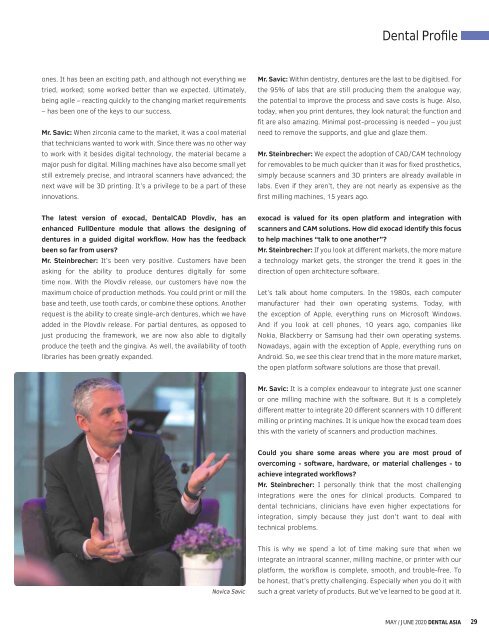Dental Asia May/June 2020
For more than two decades, Dental Asia is the premium journal in linking dental innovators and manufacturers to its rightful audience. We devote ourselves in showcasing the latest dental technology and share evidence-based clinical philosophies to serve as an educational platform to dental professionals. Our combined portfolio of print and digital media also allows us to reach a wider market and secure our position as the leading dental media in the Asia Pacific region while facilitating global interactions among our readers.
For more than two decades, Dental Asia is the premium journal in linking dental innovators
and manufacturers to its rightful audience. We devote ourselves in showcasing the latest dental technology and share evidence-based clinical philosophies to serve as an educational platform to dental professionals. Our combined portfolio of print and digital media also allows us to reach a wider market and secure our position as the leading dental media in the Asia Pacific region while facilitating global interactions among our readers.
You also want an ePaper? Increase the reach of your titles
YUMPU automatically turns print PDFs into web optimized ePapers that Google loves.
<strong>Dental</strong> Profile<br />
ones. It has been an exciting path, and although not everything we<br />
tried, worked; some worked better than we expected. Ultimately,<br />
being agile – reacting quickly to the changing market requirements<br />
– has been one of the keys to our success.<br />
Mr. Savic: When zirconia came to the market, it was a cool material<br />
that technicians wanted to work with. Since there was no other way<br />
to work with it besides digital technology, the material became a<br />
major push for digital. Milling machines have also become small yet<br />
still extremely precise, and intraoral scanners have advanced; the<br />
next wave will be 3D printing. It’s a privilege to be a part of these<br />
innovations.<br />
Mr. Savic: Within dentistry, dentures are the last to be digitised. For<br />
the 95% of labs that are still producing them the analogue way,<br />
the potential to improve the process and save costs is huge. Also,<br />
today, when you print dentures, they look natural; the function and<br />
fit are also amazing. Minimal post-processing is needed – you just<br />
need to remove the supports, and glue and glaze them.<br />
Mr. Steinbrecher: We expect the adoption of CAD/CAM technology<br />
for removables to be much quicker than it was for fixed prosthetics,<br />
simply because scanners and 3D printers are already available in<br />
labs. Even if they aren’t, they are not nearly as expensive as the<br />
first milling machines, 15 years ago.<br />
The latest version of exocad, <strong>Dental</strong>CAD Plovdiv, has an<br />
enhanced FullDenture module that allows the designing of<br />
dentures in a guided digital workflow. How has the feedback<br />
been so far from users?<br />
Mr. Steinbrecher: It’s been very positive. Customers have been<br />
asking for the ability to produce dentures digitally for some<br />
time now. With the Plovdiv release, our customers have now the<br />
maximum choice of production methods. You could print or mill the<br />
base and teeth, use tooth cards, or combine these options. Another<br />
request is the ability to create single-arch dentures, which we have<br />
added in the Plovdiv release. For partial dentures, as opposed to<br />
just producing the framework, we are now also able to digitally<br />
produce the teeth and the gingiva. As well, the availability of tooth<br />
libraries has been greatly expanded.<br />
exocad is valued for its open platform and integration with<br />
scanners and CAM solutions. How did exocad identify this focus<br />
to help machines “talk to one another”?<br />
Mr. Steinbrecher: If you look at different markets, the more mature<br />
a technology market gets, the stronger the trend it goes in the<br />
direction of open architecture software.<br />
Let’s talk about home computers. In the 1980s, each computer<br />
manufacturer had their own operating systems. Today, with<br />
the exception of Apple, everything runs on Microsoft Windows.<br />
And if you look at cell phones, 10 years ago, companies like<br />
Nokia, Blackberry or Samsung had their own operating systems.<br />
Nowadays, again with the exception of Apple, everything runs on<br />
Android. So, we see this clear trend that in the more mature market,<br />
the open platform software solutions are those that prevail.<br />
Mr. Savic: It is a complex endeavour to integrate just one scanner<br />
or one milling machine with the software. But it is a completely<br />
different matter to integrate 20 different scanners with 10 different<br />
milling or printing machines. It is unique how the exocad team does<br />
this with the variety of scanners and production machines.<br />
Could you share some areas where you are most proud of<br />
overcoming - software, hardware, or material challenges - to<br />
achieve integrated workflows?<br />
Mr. Steinbrecher: I personally think that the most challenging<br />
integrations were the ones for clinical products. Compared to<br />
dental technicians, clinicians have even higher expectations for<br />
integration, simply because they just don’t want to deal with<br />
technical problems.<br />
Novica Savic<br />
This is why we spend a lot of time making sure that when we<br />
integrate an intraoral scanner, milling machine, or printer with our<br />
platform, the workflow is complete, smooth, and trouble-free. To<br />
be honest, that’s pretty challenging. Especially when you do it with<br />
such a great variety of products. But we’ve learned to be good at it.<br />
MAY / JUNE <strong>2020</strong> DENTAL ASIA 29


















